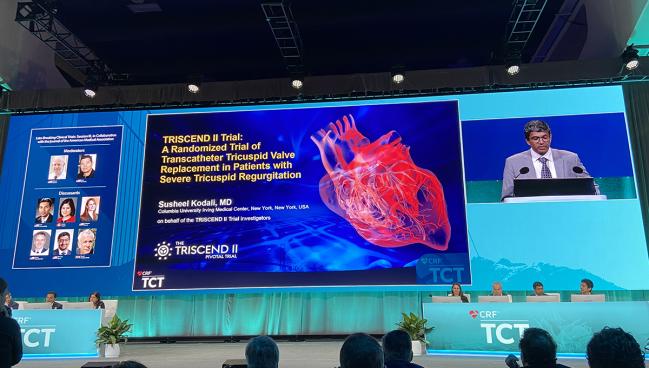‘Big Step Forward’ for Transcatheter Tricuspid Valve Replacement: TRISCEND II
TR was eliminated, safety looked good, and symptoms improved—all good news for hard-to-treat patients, say experts.

SAN FRANCISCO, CA—Patients with severe tricuspid regurgitation (TR) treated with transcatheter valve replacement experienced a significant improvement in TR grade and had “meaningful” improvements in functional status and symptoms, according to data from the first 150 patients in the TRISCEND II study.
These results were heralded as a big win for transcatheter tricuspid valve replacement given the good safety profile and near complete elimination of TR. Lead investigator Susheel Kodali, MD (NewYork-Presbyterian/Columbia University Irving Medical Center, New York, NY), said the results are welcomed because patients with severe, symptomatic TR don’t have a lot of options.
“The ones that tend to go for surgery are younger and healthier,” Kodali told TCTMD. “The majority of patients with secondary TR are in their 70s and 80s. They are not getting operated on, and a number of series now have shown that their mortality is high.”
Today during a late-breaking clinical trial session at TCT 2023, TRISCEND II investigators reported that roughly 10% of patients had a severe bleed—likely attributable to the need for anticoagulation—and 15% required permanent pacing. Still, the primary safety endpoint at 30 days—a composite of adjudicated major adverse events—was less than expected and deemed well within the acceptable threshold, according to investigators.
This device, unlike TEER, eliminates TR. Susheel Kodali
Neil Fam, MD (University of Toronto/St. Michael’s Hospital, Canada), who performed the first-in-human transcatheter tricuspid valve replacement with Evoque (Edwards Lifesciences) more than 4 years ago, called TRISCEND II a “big step forward.” Even back then, early outcomes looked good, but they’ve since gotten better.
“We were immediately impressed with the first 25 cases that were done [at multiple centers],” he told TCTMD. “There was no mortality and about an 8% or 10% rate of pacemaker [implantation]. Now you fast-forward to this randomized trial and the safety is actually improving compared with the TRISCEND I early feasibility study. Major bleeding has been cut nearly in half.”
Similarly, Sam Dawkins, MD, PhD (Oxford University Hospitals NHS Foundation Trust and Cleveland Clinic London, England), said TRISCEND II was one of the most eagerly anticipated studies at the meeting.
“This is quite an important group of patients,” Dawkins told TCTMD. “We are able to offer transcatheter edge-to-edge repair, but there’s a group of patients where you can’t do that, such as in people with very large coaptation gaps, those with a very dilated annulus, or those with pacing leads that are splinting the valve open—that’s quite a big group. Transcatheter edge-to-edge repair isn’t in the cards for them, and surgery is very high risk and [infrequently performed]. A transcatheter tricuspid valve replacement device is treating a group for whom we have nothing.”
Designated Breakthrough Device
In 2019, the US Food and Drug Administration deemed Evoque a “breakthrough” therapy to help facilitate patient access (it is not yet approved in the US, but received CE Mark approval in Europe just last week). The TRISCEND II study, which will ultimately include 400 patients, was devised to allow for analysis of these first 150 patients randomized in the study.
Patients were approximately 79 years old, and nearly 80% were female. The mean STS score—used to estimate risk of mitral valve surgery given the absence of a tricuspid surgery risk score—was roughly 10%. Nearly all patients had atrial fibrillation at baseline and 35% to 40% had a preexisting pacemaker/implantable cardioverter defibrillator. More than 77% of patients undergoing transcatheter tricuspid valve replacement had secondary TR.
In the Evoque/optimal medical therapy (OMT) arm, 43.8% had severe TR at baseline, 21.9% had massive TR, and 34.4% had torrential TR. In the OMT-alone group, severe, massive, and torrential TR was present at baseline in 40.7%, 27.8%, and 31.5% of patients.
A transcatheter tricuspid valve replacement device is treating a group for whom we have nothing. Sam Dawkins
At 30 days, the primary composite safety endpoint occurred in 27.4% of the 95 patients treated with transcatheter valve replacement, a rate that compared favorably with historic safety data after tricuspid valve surgery (43.8%). Severe bleeding (10.5%) and the need for permanent pacing (14.7%) were the two most commonly adjudicated adverse events. There was a single case of device-related pulmonary embolism. Cardiovascular mortality was 3.2%.
At 6 months, transcatheter tricuspid valve replacement “virtually eliminated” TR, according to investigators. Overall, 98.8% of patients had moderate or less TR and 93.8% had mild or less. Nearly 78% had none/trace TR. With OMT, just 21.6% had moderate or less TR, with more than 50% continuing to have massive or torrential regurgitation.
Improvements in quality of life and functional status, assessed as a hierarchical composite endpoint that measured changes in Kansas City Cardiomyopathy Questionnaire (KCCQ; ≥ 10 points), NYHA functional class (≥ 1 class), and 6-minute walk test distance (≥ 30 meters), were superior with transcatheter tricuspid valve replacement (win ratio 4.6).
The difference in the mean change in KCCQ score compared with OMT was 17.8 points, while the mean difference in distance with the 6-minute walk test was 30.9 m. Additionally, 90.0% of patients treated with Evoque/OMT had NYHA I/II symptoms at 6 months compared with 34.2% of those treated with OMT alone.
Mortality ‘Very Encouraging’
To TCTMD, Dawkins said that one of the challenges with transcatheter tricuspid valve replacement is that transcatheter edge-to-edge repair (TEER) is “spectacularly safe.” In TRILUMINATE, for example, the 30-day mortality rate was 0.6% with TriClip (Abbott) in a group of patients with extensive comorbidities.
“Now, tricuspid replacement is a higher-risk proposition than repair, but that has to be put into context with the terrible outcomes of severe tricuspid regurgitation,” he said. “They really don’t do well. I was encouraged in TRISCEND II to see that 30-day mortality was low in a very comorbid patient population: 3% mortality for tricuspid replacement for such comorbid patients is very encouraging.”
The learning curve with implantation is straightforward, said Kodali, calling it a “trainable, teachable procedure.” Imaging with valve replacement is less important than with TEER, he said, as operators don’t need to visualize the leaflets as closely. “That’s part of the shortening of the learning curve,” he said, “because the learning curve is not just the interventionalist but the entire team, [including] the imager.”
The possibility of permanent pacing remains the Achilles’ heel with transcatheter tricuspid valve replacement, said Fam, noting that while a rate of 15% in TRISCEND II doesn’t sound high, these conduction disturbances are unpredictable.
“With TAVI, we have very clear predictors about who’s going to get heart block and we have strategies to mitigate that,” he said. “With [transcatheter tricuspid valve replacement], ideally it happens in the hospital, but the worst is when they go home and develop syncope and heart block and you have to try to get them back in.”
To counter those risks, patients are frequently sent home with 14-day Holter monitoring, he said. “Future strategies are to iterate devices to make them softer, with less radial force in the annulus, where the anchors are not as aggressively digging into the septum where the conduction system lies,” said Fam.
To TCTMD, Wayne Batchelor, MD (Inova Heart and Vascular Institute, Falls Church, VA), said that it can be challenging to deal with pacing leads in patients undergoing transcatheter valve replacement. If they have a preexisting device, the leads can be jailed with the replacement tricuspid valve, and it can also be difficult place a lead after the valve has been implanted. He is hopeful that that advances in leadless pacemaker technology might provide a solution.
Mortality or Patient-Reported Outcomes
With the full TRISCEND II patient population, investigators will take a look at harder clinical endpoints, with the 1-year composite endpoint including all-cause mortality, need for right ventricular assist device/heart transplant, need for tricuspid valve surgery or intervention, heart failure hospitalization, and KCCQ/NYHA functional class/6-minute walk distance.
One of the major questions going forward with transcatheter tricuspid therapies—whether that’s repair or replacement—is whether patient-reported outcomes, such as quality of life, should be enough to drive device approval and reimbursement. During a TCT 2023 FDA Town Hall, Suzanne Arnold, MD (Saint Luke’s Mid America Heart Institute, Kansas City, MO), and Nir Uriel, MD (NewYork-Presbyterian/Columbia University Irving Medical Center), debated this very topic, with Uriel pointing out that the limitations in patient-reported outcomes become magnified in unblinded studies.
“Quality of life from a patient perspective is an important outcome,” Kodali told TCTMD. “The question of how you control for placebo in these trials, without a sham control, is a consideration. We have to acknowledge that there is going to be some component of a placebo effect.”
While a sham-controlled trial would be ideal, it’s not likely feasible in these type of device trials as it would be difficult to maintain blinding for 12 months or longer, he said. Additionally, undergoing transcatheter tricuspid valve replacement requires anticoagulation, raising issues about administering anticoagulation to a placebo group.
Regarding clinical events, Fam said there are data showing that improvements in KCCQ scores in patients with severe TR track with a lower risk of death and heart failure hospitalizations. “If you read the tea leaves, the longer you follow these patients, maybe we’ll see some change in hard outcomes,” said Fam. He pointed out, like others, that quality of life is a very valid endpoint in these patients.
“As cardiologists, we’re all obsessed with death and heart failure, but in the end, the only patients I see in my practice who can stop diuretics and feel great are [transcatheter tricuspid valve replacement] patients,” he said. “That means a lot for them.” The improvement in quality of life, Fam added, is on par with the benefits seen with TAVI.
Dawkins believes a quality-of-life benefit should be enough to see the device approved in more countries, including the US, and to be reimbursed. “There are very few medical interventions that have a mortality benefit,” he said. “I personally don’t think we need to set bar as a high as that. I do think if we identify the right group of patients, we will find a mortality benefit, but there are a lot more who stand to benefit from quality-of-life improvements.”
Kodali thinks researchers, along with regulators, should assess the totality of evidence to get a handle on replacement’s advantages. They’ll want to see individual endpoints trending in the right direction, including not only mortality and heart failure hospitalizations, but also RV remodeling and size. “The severity of TR affects impacts 1- and 2-year survival in population studies,” he said. “This device, unlike TEER, eliminates TR. Whether that elimination of TR will translate into an improvement in mortality is what we need to see at 1 year—we hope it does.”
He speculated, though, that in order for a reduction in hard clinical endpoints to be seen, they might need to follow patients for longer than 1 year or to include even sicker patients.
Roxana Mehran, MD (Icahn School of Medicine at Mount Sinai, New York, NY), who moderated the TCT press conference, believes that for transcatheter tricuspid valve replacement to gain approval, researchers will need to demonstrate a clinical benefit, even if it’s a reduction in heart failure hospitalizations. While improvements in quality of life are important, she said, that should be placed in the context of reduced clinical events.
Michael O’Riordan is the Managing Editor for TCTMD. He completed his undergraduate degrees at Queen’s University in Kingston, ON, and…
Read Full BioSources
Kodali S, on behalf of the TRISCEND II investigators. TRISCEND II trial: a randomized trial of transcatheter tricuspid valve replacement in patients with severe tricuspid regurgitation. Presented at: TCT 2023. October 26, 2023. San Francisco, CA.
Disclosures
- Kodali reports grant support from Edwards Lifesciences, Medtronic, Boston Scientific, Abbott Vascular, and JenaValve. He reports consulting fees from Anteris, Dura Biotech, Shi famed, Tricares, Phillips, Nyra Medical, and Helix Valve Repair. He has equity in Thubrikar Aortic Valve, Dura Biotech, Supira, MID, TriFlo, Adona, Tioga, Xdot, Moray Medical, and Cardiomech.







Comments